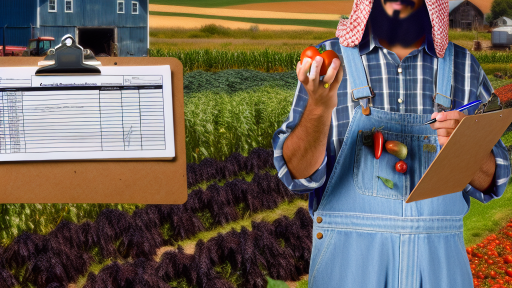Introduction to Inventory Management for Direct-to-Consumer Farms
Inventory management is crucial for direct-to-consumer farms.
Effective inventory control enhances efficiency and profit margins.
Farms must manage their stock to meet customer demands.
Additionally, avoiding surplus prevents waste and reduces costs.
Understanding Inventory Needs
Farms need to evaluate their inventory needs based on demand.
This approach helps determine what products to grow and sell.
Accurate forecasting can maximize sales and minimize losses.
Implementing Inventory Systems
Choosing the right inventory management system is essential.
Modern technology offers various tools and software for tracking inventory.
These systems can provide real-time data on stock levels.
Dynamic Stock Management
Direct-to-consumer farms should adopt dynamic stock management.
This strategy allows for adjustments based on market trends.
Regularly reviewing sales data can inform necessary changes.
Establishing Restocking Procedures
Establishing clear restocking procedures is important.
Farmers should determine optimal stock levels for efficient operations.
Transform Your Agribusiness
Unlock your farm's potential with expert advice tailored to your needs. Get actionable steps that drive real results.
Get StartedAutomated alerts can assist in timely restocking.
Engaging with Customers
Communication with customers can aid in inventory management.
Surveys and feedback can reveal consumer preferences and trends.
Incorporating this feedback helps adjust inventory accordingly.
Monitoring and Adjusting Inventory Practices
Continuous monitoring of inventory practices ensures effectiveness.
Farmers should analyze inventory turnover rates regularly.
Adjusting strategies based on performance metrics is critical.
Understanding the Importance of Accurate Inventory Tracking
Enhancing Operational Efficiency
Accurate inventory tracking directly boosts operational efficiency.
Farmers can manage resources better when they know inventory levels.
This awareness leads to informed decision-making regarding planting and harvesting.
Moreover, it minimizes waste, saving both time and costs.
Meeting Consumer Demand
Consumers today expect fresh products and timely deliveries.
Accurate inventory helps farmers meet these expectations consistently.
Furthermore, proper tracking prevents stockouts and overstock situations.
Both issues can harm the farmer’s reputation and sales.
Financial Management
Effective inventory management influences a farm’s financial health.
It allows for better cash flow management and reduces excess spending.
Farmers can make strategic purchasing decisions based on accurate data.
This approach helps avoid overinvestment in unneeded inventory.
Compliance and Traceability
Many regions require compliance with food safety regulations.
Accurate inventory records enhance product traceability during audits.
This transparency reassures customers about food origins and safety.
Consequently, it fosters trust between farmers and consumers.
Utilizing Technology
Modern inventory management systems streamline tracking processes.
Showcase Your Farming Business
Publish your professional farming services profile on our blog for a one-time fee of $200 and reach a dedicated audience of farmers and agribusiness owners.
Publish Your ProfileThese systems provide real-time data accessible from any location.
Farmers can monitor their stock levels effortlessly using mobile devices.
As a result, they can make timely adjustments to their operations.
Common Inventory Management Practices in Farming
Understanding Inventory Management
Inventory management is crucial for farms operating direct-to-consumer sales.
It involves tracking stock levels and managing supplies effectively.
By practicing good inventory management, farms can meet consumer demand efficiently.
Implementing Effective Inventory Systems
Many farms rely on digital inventory management systems.
Software like FarmLogs or CropTracker can streamline operations.
These tools help in monitoring inventory in real-time.
Furthermore, they assist in making data-driven decisions.
Using Forecasting Techniques
Forecasting helps farms anticipate inventory needs.
Analyzing historical sales data can reveal trends and seasonality.
As a result, farmers can adjust their production accordingly.
This proactive approach minimizes overproduction and waste.
Regular Inventory Audits
Conducting regular inventory audits is essential for accuracy.
These audits reveal discrepancies and help maintain precise records.
Farmers should schedule audits seasonally or quarterly.
This practice ensures that inventory data aligns with physical stock.
Establishing Supplier Relationships
Building strong relationships with suppliers benefits farms greatly.
Reliable suppliers provide consistent product quality and availability.
Furthermore, solid relationships can lead to better negotiation terms.
This contributes to more effective inventory management.
Utilizing Technology for Tracking
Modern technology enhances inventory tracking significantly.
Farmers use tools like barcode scanners or RFID systems.
These technologies streamline inventory updates and access to information.
Consequently, they reduce human error and save time.
Training Staff on Inventory Practices
Employees play a critical role in effective inventory management.
Training staff on proper inventory procedures is vital.
Knowledgeable workers are more efficient at handling stock.
Ongoing training sessions keep employees updated on best practices.
Implementing First-In-First-Out (FIFO) System
The FIFO inventory method ensures older stock is sold first.
This method reduces spoilage, particularly for perishable goods.
By applying FIFO, farms can maintain product freshness.
Ultimately, this practice enhances customer satisfaction.
Adapting to Market Changes
Flexibility is key to managing inventory effectively.
Farms must respond to sudden shifts in consumer demand.
Adapting inventory strategies helps mitigate lost sales opportunities.
Additionally, it preserves revenue during market fluctuations.
Learn More: Effective Crop Rotation Strategies for Small Farms
Utilizing Technology for Efficient Inventory Management
Importance of Inventory Management
Inventory management plays a vital role in direct-to-consumer farming.
Showcase Your Farming Business
Publish your professional farming services profile on our blog for a one-time fee of $200 and reach a dedicated audience of farmers and agribusiness owners.
Publish Your ProfileIt ensures that products are available when needed.
Moreover, effective management helps prevent waste.
This is essential for maintaining profitability.
Integrating Inventory Management Systems
An inventory management system streamlines operations significantly.
First, it tracks stock levels in real-time.
Next, it provides alerts for low stock situations.
This feature helps prevent out-of-stock issues.
Additionally, these systems often integrate with point-of-sale software.
This connection creates a seamless transaction process.
Utilizing Mobile Applications
Mobile inventory applications offer flexibility for farmers.
They allow for inventory updates on-the-go.
This is particularly useful during farm visits or markets.
Furthermore, mobile apps enable quick scanning of barcodes.
This speeds up the inventory counting process considerably.
Analyzing Data for Demand Prediction
Data analytics improves inventory decision-making.
It helps forecast demand based on historical data.
By understanding buying patterns, farmers can adjust inventory levels.
This proactive approach reduces excess inventory.
Ultimately, it enhances customer satisfaction.
Training and Support
Proper training on technology is crucial.
Farmers should understand how to use inventory systems effectively.
Support from technology providers ensures smooth operation.
This can include tutorials and customer service assistance.
Training enhances overall productivity.
Uncover the Details: Top Agri-Tourism Activities for Farm Visitors
Strategies for Forecasting Demand Based on Customer Trends
Understanding Customer Preferences
Gather data on what customers buy regularly.
Analyze seasonal purchasing trends to anticipate demand.
Offer surveys to gauge customer preferences and interests.
Engage with customers through social media for insights.
Utilize sales data to identify popular products.
Utilizing Inventory Management Tools
Implement software tools to track inventory levels efficiently.
Choose a system that offers real-time updates on stock status.
Use forecasting features to estimate future demand accurately.
Integrate sales data with your inventory management system.
This integration enhances the decision-making process.
Monitoring Market Trends
Stay informed about agricultural market trends that impact demand.
Follow industry reports to understand consumer behavior shifts.
Attend agricultural fairs to network and gather insights.
Analyze competitor activities to gauge market shifts.
Adjust inventory strategies based on market dynamics.
Showcase Your Farming Business
Publish your professional farming services profile on our blog for a one-time fee of $200 and reach a dedicated audience of farmers and agribusiness owners.
Publish Your ProfileSeasonal Adjustments
Plan inventory around seasonal production cycles.
Schedule promotions during peak buying seasons.
Adjust stock levels before major holidays and events.
Offer seasonal products that align with customer needs.
Use weather forecasts to prepare for demand variations.
Feedback Mechanisms
Encourage customers to provide feedback after purchases.
Analyze customer reviews to identify improvement areas.
Use feedback data to refine your product offerings.
Implement changes based on suggestions from your customer base.
This approach fosters loyalty and increases repeat purchases.
Gain More Insights: Animal Welfare In Modern Farming
Best Practices for Stock Rotation and Waste Reduction
Understanding Stock Rotation
Stock rotation helps maintain the freshness of products.
By using the FIFO method, you sell older items first.
This practice reduces waste and improves customer satisfaction.
Farmers should regularly assess their inventory levels.
Monitoring expiration dates is essential for perishable goods.
Establish clear guidelines for how to rotate stock.
Implementing Effective Waste Reduction Strategies
Waste reduction starts with accurate demand forecasting.
Analyze historical sales data to predict future needs.
This analysis helps optimize order quantities.
Collaborate with local food banks to donate unsold items.
Composting food waste can also benefit farm operations.
Establish partnerships with organizations that accept surplus produce.
Utilizing Technology for Inventory Management
Investing in inventory management software is advantageous.
These tools provide real-time tracking of stock levels.
Automated alerts can notify you of low inventory items.
Additionally, software simplifies product labeling and tracking.
Technology reduces human error and enhances efficiency.
Training Employees on Best Practices
Educating staff is vital to effective inventory management.
Provide training on proper stock rotation techniques.
Encourage employees to report any inventory issues promptly.
Create a culture of waste reduction within the team.
This approach empowers employees to take ownership.
Regular Evaluation of Inventory Practices
Conduct regular reviews of your inventory management practices.
Identify areas for improvement based on performance metrics.
Adapt practices based on changing market conditions.
Continuous evaluation prevents chronic waste issues.
Seek feedback from employees to enhance processes.
Uncover the Details: Agri-Tourism Ideas to Boost Your Farming Business

Creating a User-Friendly Inventory Management System
Understanding Your Inventory Needs
Begin by assessing your farm’s inventory requirements.
Showcase Your Farming Business
Publish your professional farming services profile on our blog for a one-time fee of $200 and reach a dedicated audience of farmers and agribusiness owners.
Publish Your ProfileIdentify key products and their turnover rates.
Consider seasonal variations in demand.
Additionally, analyze past sales data to forecast future needs.
Choosing the Right Inventory Management Tools
Select software that aligns with your operational scale.
Options range from simple spreadsheets to comprehensive systems.
Ensure compatibility with other tools you currently use.
A user-friendly interface can make a significant difference.
Implementing Inventory Tracking Techniques
Employ barcoding or QR codes for efficient tracking.
This process minimizes errors and speeds up data entry.
Regularly update inventory levels to reflect real-time stock.
Establish a clear protocol for inventory audits.
Training Your Staff
Provide thorough training on your chosen system.
Make sure staff understand inventory best practices.
Encourage them to ask questions and share feedback.
Ongoing training can enhance efficiency.
Reviewing and Optimizing Your System
Regularly analyze your inventory management practices.
Identify bottlenecks or issues in your workflow.
Consider adapting your methods based on performance data.
Optimization leads to better resource management.
Evaluating Inventory Performance and Making Adjustments
Assessing Current Inventory Levels
Regularly assess your inventory to understand current levels.
Accurate data enables informed decision-making.
Use inventory management software for precise tracking.
This technology simplifies calculations and reduces errors.
Analyzing Sales Trends
Sales data reveals trends that impact inventory needs.
Examine sales patterns over time to identify seasonal changes.
Adjust your inventory based on these insights.
For instance, anticipate higher demand during holidays.
Implementing Inventory KPIs
Key performance indicators (KPIs) help monitor inventory efficiency.
Consider tracking metrics like inventory turnover and stockout rates.
These KPIs highlight areas needing improvement.
Regularly report on these metrics to your team.
Making Adjustments to Inventory
Use your assessment and analysis to make necessary adjustments.
Reduce stock on slow-moving items to free up resources.
Conversely, increase stock on popular products to meet demand.
This strategic approach maximizes sales opportunities.
Engaging with Customers for Feedback
Customer input is invaluable for managing inventory.
Gather feedback through surveys or direct communication.
This data can reveal preferences and trends.
Actively engaging customers enhances their satisfaction.
Planning for Seasonal Variations
Seasonal fluctuations greatly impact inventory needs.
Showcase Your Farming Business
Publish your professional farming services profile on our blog for a one-time fee of $200 and reach a dedicated audience of farmers and agribusiness owners.
Publish Your ProfilePlan ahead based on previous years’ sales data.
Stock up on items likely to be in demand during busy seasons.
This preparation helps avoid stock shortages.
Continuously Monitoring and Adjusting Strategy
Inventory management requires ongoing monitoring.
Regularly review your strategies to ensure effectiveness.
Be willing to adapt to new market conditions.
This flexibility enhances your responsiveness to changes.
The Future of Inventory Management in Direct-to-Consumer Farming
Embracing Technology
Technology will revolutionize inventory management for farms.
Farmers must adopt software solutions for tracking inventory.
These tools will help streamline processes and reduce errors.
Data analytics can provide insights into consumer demand.
Moreover, farmers can optimize their supply chain through technology.
Enhancing Customer Experience
Effective inventory management directly improves customer satisfaction.
When farmers manage stock levels accurately, they meet consumer needs.
Increased transparency can build trust with customers.
Farmers could consider offering real-time updates on availability.
This approach fosters loyalty and repeat purchases.
Sustainable Practices
Sustainability will shape future inventory management strategies.
Farmers must prioritize eco-friendly approaches.
Implementing sustainable practices is essential for long-term viability.
This means minimizing waste in inventory processes.
Moreover, sustainable sourcing can enhance brand reputation.
Collaboration and Community Engagement
Collaboration among local farms can enhance inventory management.
Sharing resources improves efficiency.
Farmers can pool inventories to meet larger orders.
Engaging with local communities creates strong support networks.
Consequently, farmers can benefit from shared knowledge and resources.
Future Trends
Future trends include automation in inventory control.
Robotics and IoT devices will increasingly support farming practices.
This technology will allow for real-time inventory monitoring.
Additionally, AI can predict trends and optimize inventory levels.
Ultimately, these advancements will drive profitability and reduce waste.




